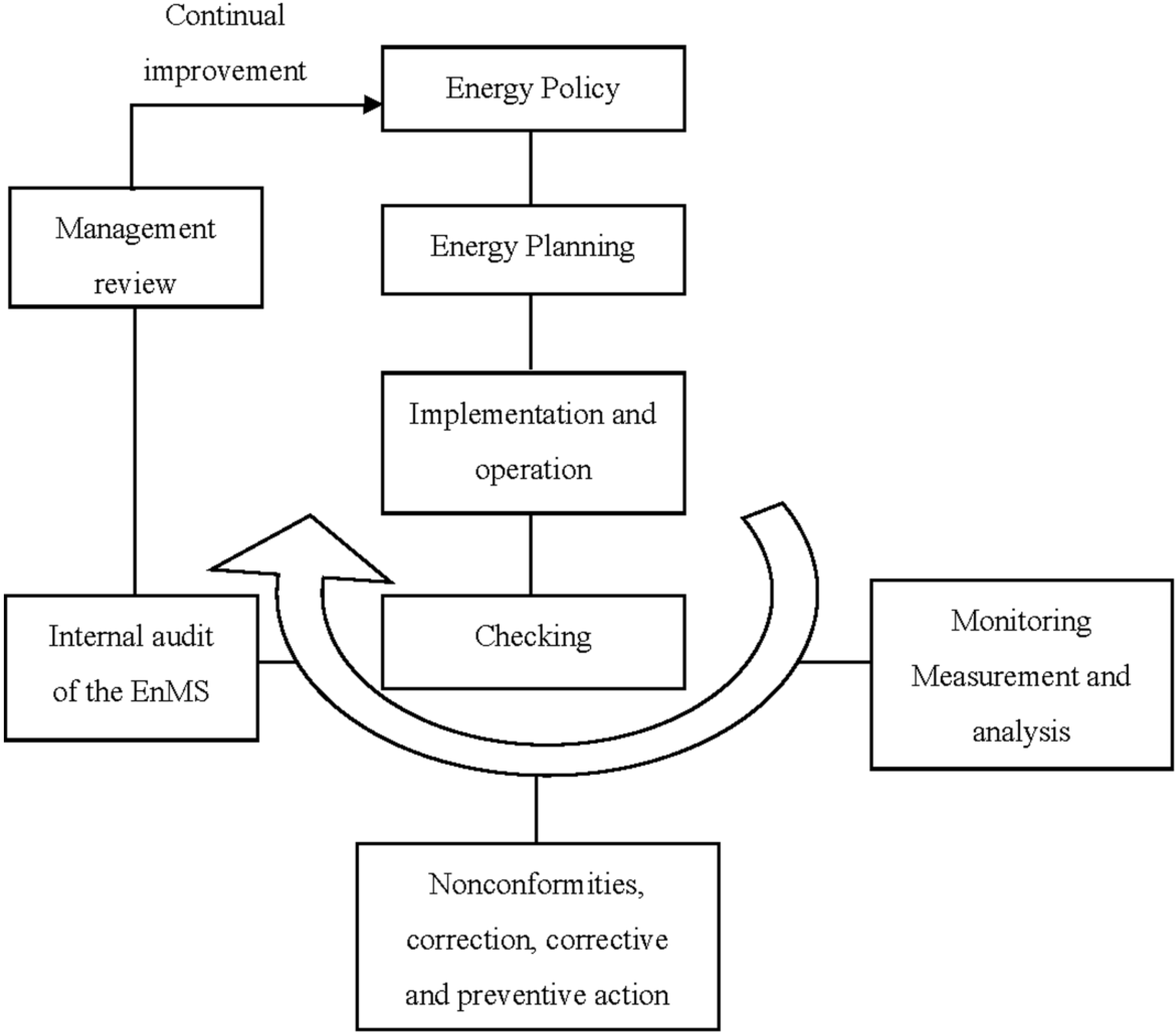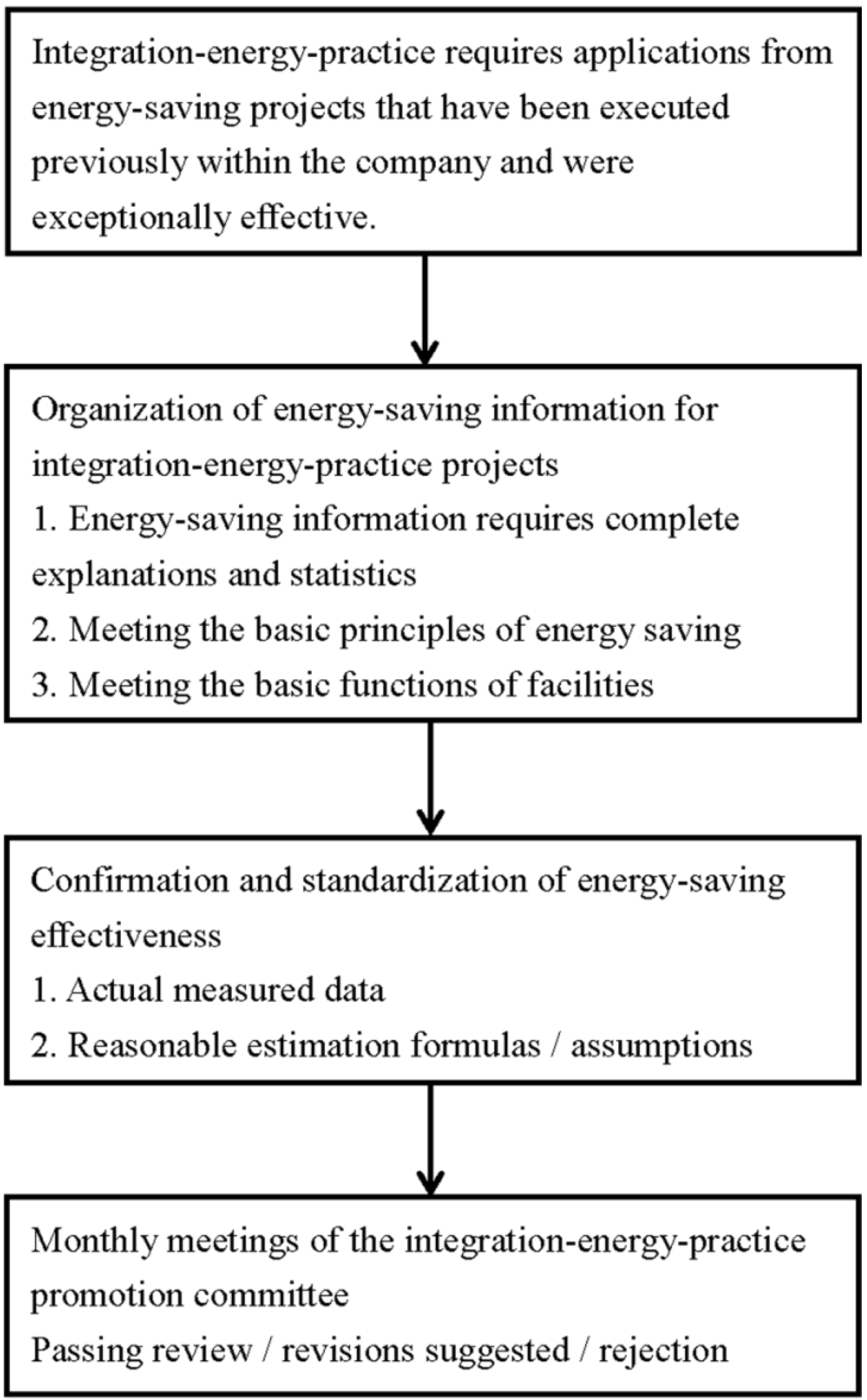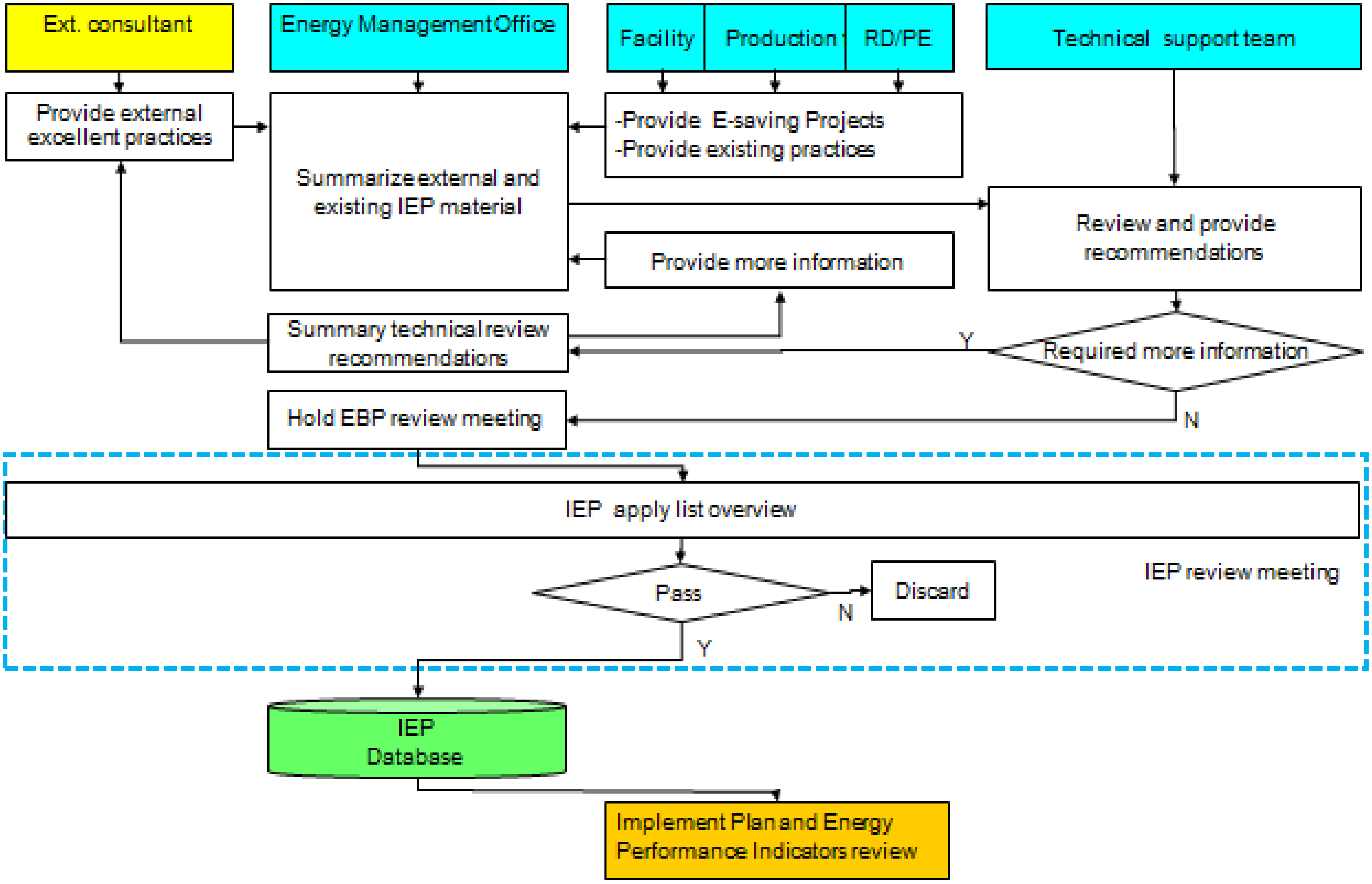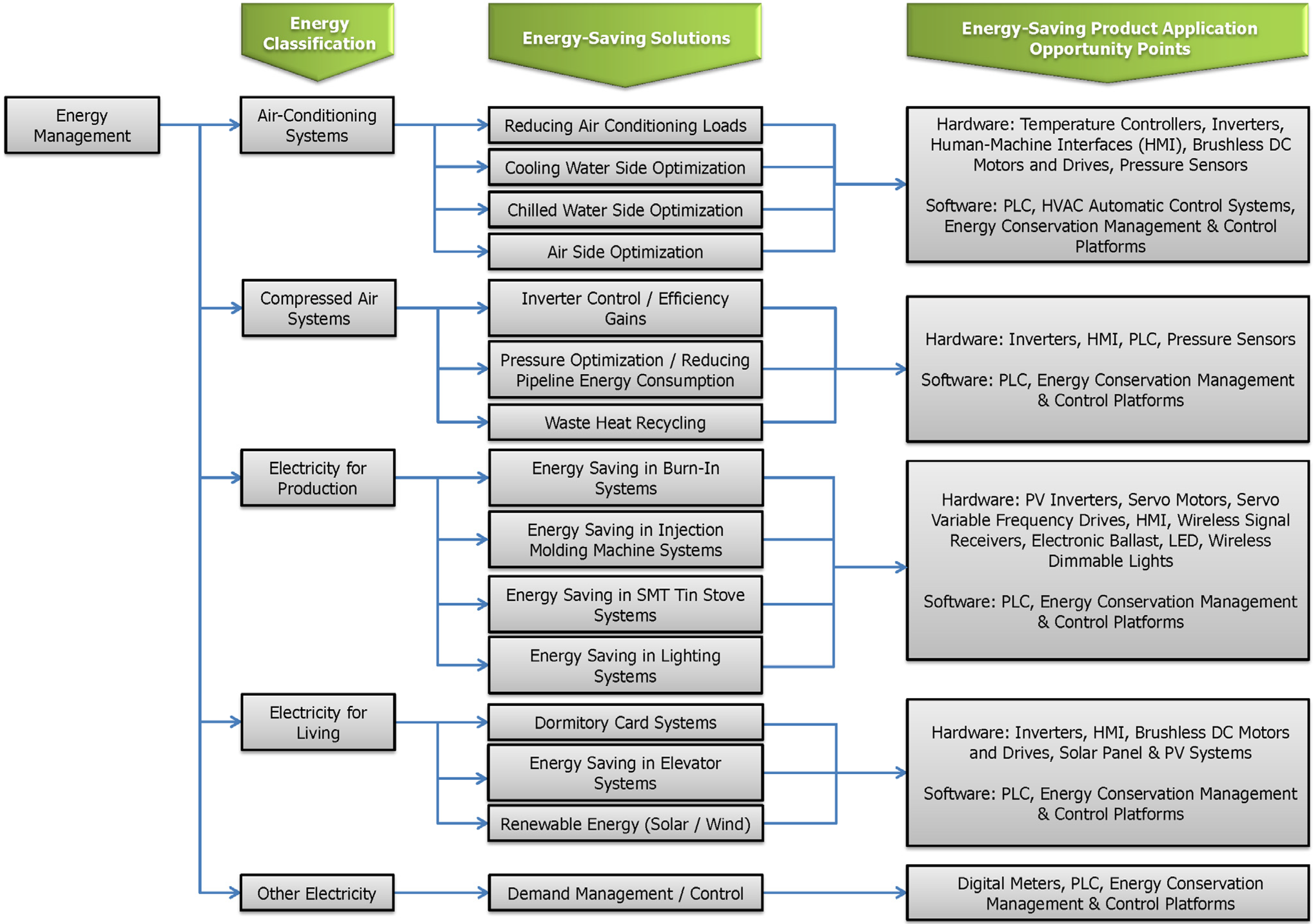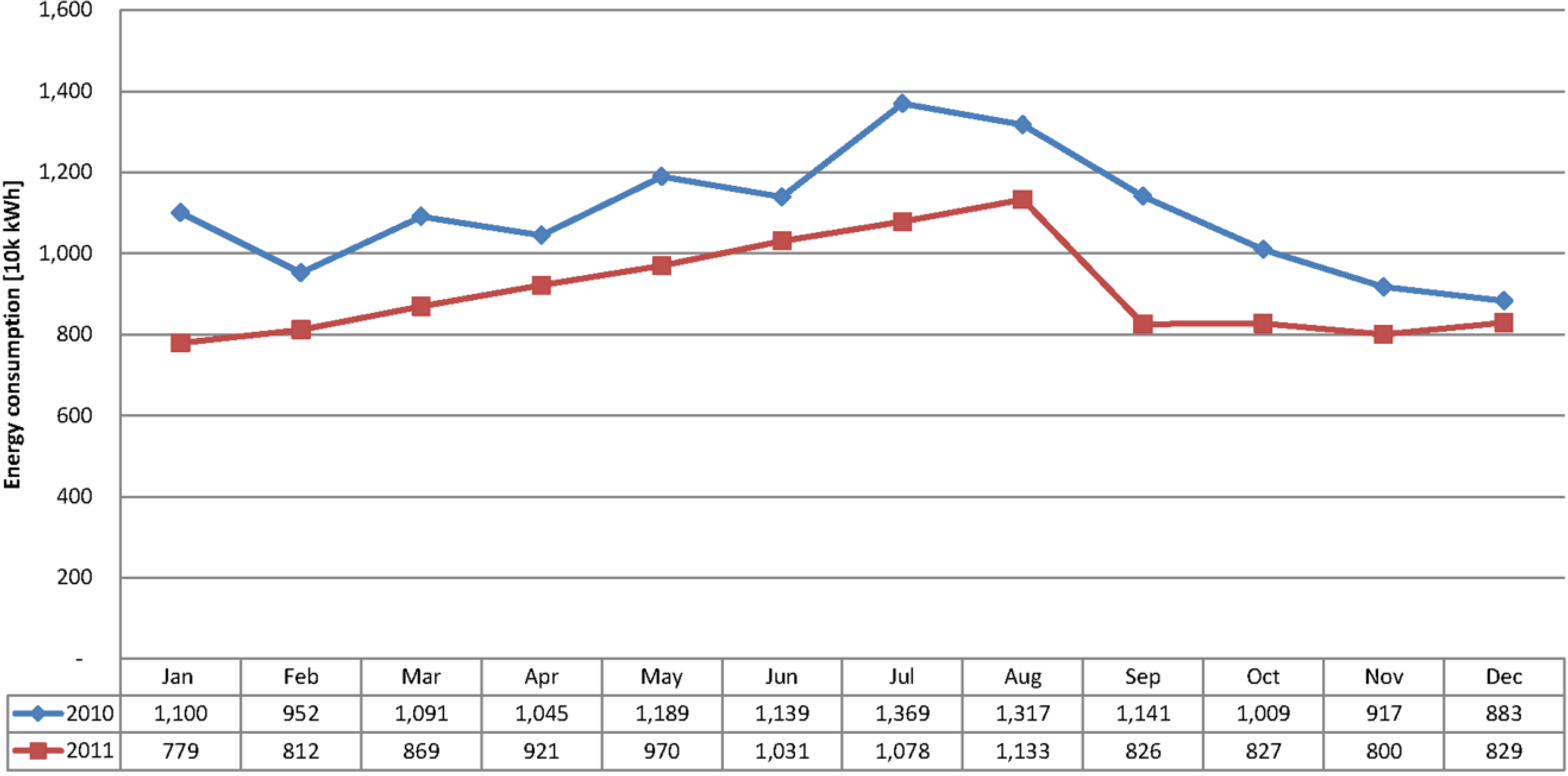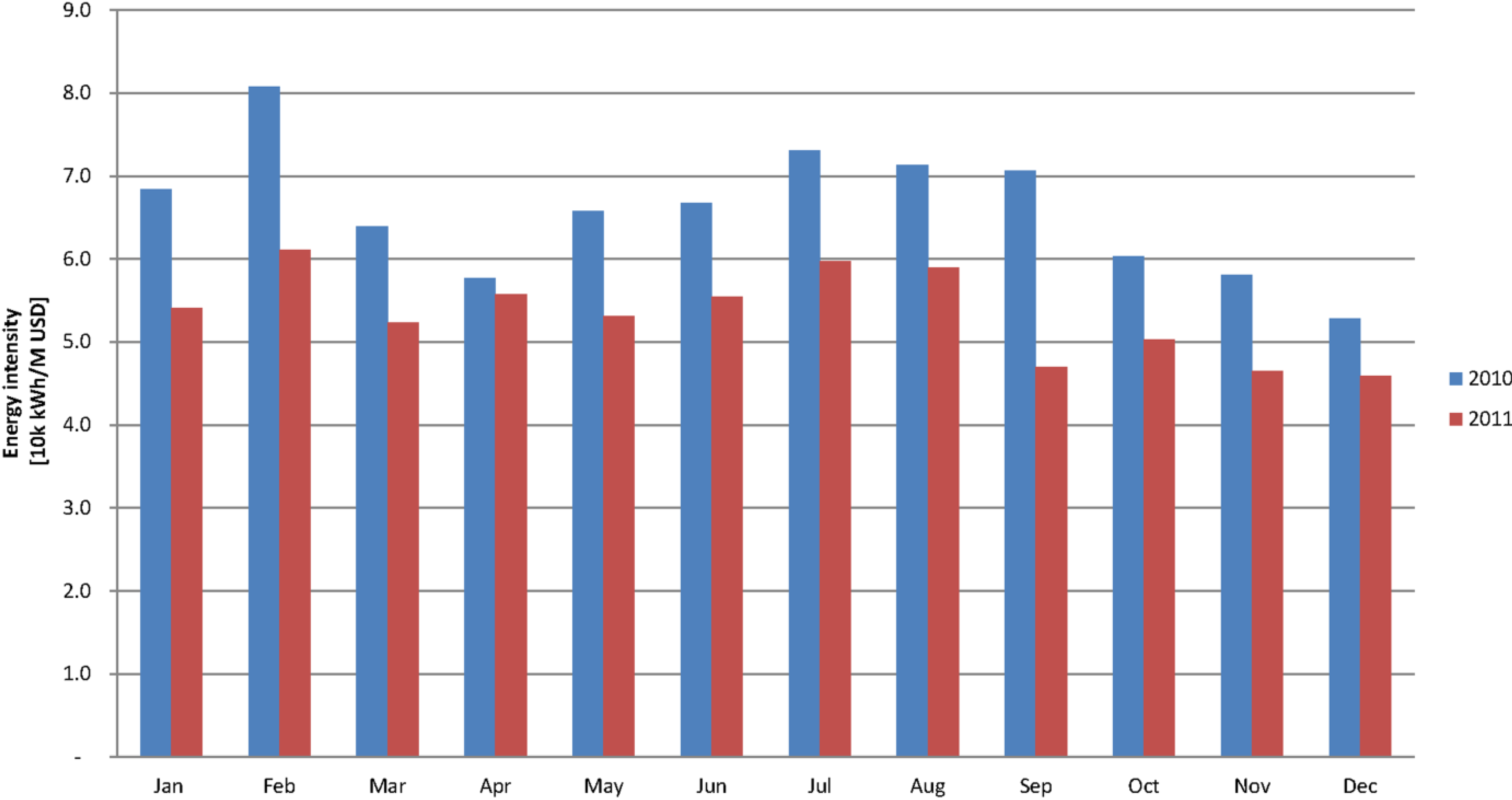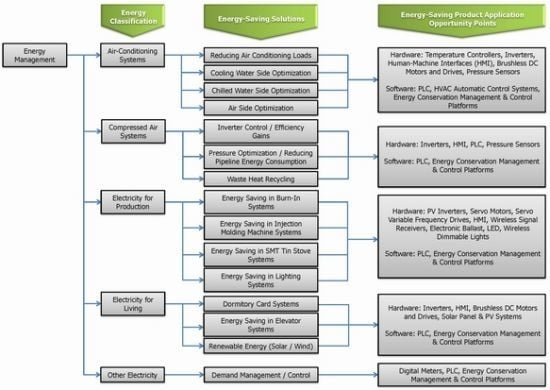1. Introduction
Confronted with a worldwide energy crisis and continual price increases, governments and businesses are actively formulating energy management regulations and developing technology to improve energy-use efficiency, thereby reducing greenhouse gas emissions and improving the management of the Earth’s limited resources [
1,
2,
3]. Related studies have examined the influence of carbon dioxide produced by energy consumption on environmental change [
4,
5]. The mission of numerous organizations and businesses involves developing product design, production, and manufacturing, and optimizing sales and services to gain profits. They do not, however, specialize in improving energy-use efficiency. Moreover, organizations and businesses encounter difficulties in determining which types of energy they require, understanding energy prices, and controlling stable supply sources [
6,
7]. The International Organization for Standardization (ISO) officially announced the ISO 50001 management system on 15 June 2011, after numerous meetings and discussions [
8]. This standard can be applied to any organization or enterprise in the World. It establishes a standardized document process platform for systematic energy management and for improving energy-use efficiency.
Although the ISO 50001 energy management system architecture is similar to the ISO 9001 quality management system and the ISO 14001 environmental management system announced by the ISO, it includes unique energy management demands and special technical definitions, such as those found in its provisions and demands regarding energy performance indicators and significant energy use [
9,
10]. Therefore, organizations and enterprises planning to introduce the new international energy standards of ISO 50001 are confronted with problems and challenges when integrating energy management and technology, formulating energy performance indicators, mitigating technological bottlenecks to improving energy efficiency, and managing third-party certification [
11]. The demand items in ISO 50001 include energy technology items that necessitate, for example, the involvement of consultants with experience in related technology fields to measure and monitor various detection devices for public facilities and production equipment [
12]. Thus, an integration-energy-practice model was used to improve the energy performance indicators in the ISO 50001 energy management system and satisfy the regulations and standardized document procedures of ISO 50001 energy management demands. This model passes the two-stage international auditing and certification procedures performed by third-party units and can serve as a reference for organizations and enterprises to use this model for introducing and improving ISO 50001-based energy management systems.
2. Literature Review
The ISO 50001 energy management standard provides an international framework for industrial plants and companies to manage energy, including all aspects of processes and the energy management system model as
Figure 1 [
13,
14].
Figure 1.
Energy management system model of ISO 50001 based on the ISO standard [
8].
Figure 1.
Energy management system model of ISO 50001 based on the ISO standard [
8].
The goals of energy management standards can provide enterprises with an organized platform for integrated energy management performance. These goals include adjusting production processes and increasing the energy efficiency of the system [
15]. Organizations and businesses are confronted with problems and challenges when integrating energy management and technology, formulating energy performance indicators, mitigating technological bottlenecks for improving energy efficiency, and managing third-party certification when introducing an ISO 50001 energy management system.
The ISO 50001 energy management standard mandates that organizations or companies have sustainable energy management systems in place, have completed a baseline survey of energy use, and have made a commitment to continuing the improvement of energy performance [
16]. This standard specifies requirements for an energy management system, involving a systematic approach for continually improving energy efficiency and energy performance. It does not state specific performance criteria with respect to energy, and the standard applies to all organizations [
17].
The impact on the ISO 50001 energy management system, including efficient components, can yield, in best-case scenarios, efficiency gains in the range of 2%–5%. System optimization measures can attain average system efficiency gains of 20%–30% and provide a proven model that helps organizations systematically plan and manage their energy use. It is estimated that the standard could influence up to 60% of the World’s energy use [
18]. ISO 50001 provides public and private sector organizations with management strategies to increase energy efficiency, reduce costs, and improve energy performance. The standard is intended to provide organizations with a recognized framework for integrating energy performance into their management practices. Multinational organizations have access to a single, harmonized standard for implementation across organizations with a logical and consistent methodology for identifying and implementing improvements [
19].
ISO 50001 is based on the common elements of ISO management system standards, ensuring a high level of compatibility with other standards, such as ISO 9001 and ISO 14001. Specifically, ISO 50001 can help companies implement the processes necessary for understanding the baseline energy usage, execute action plans, targets, and energy performance indicators for reducing consumption, and identify, prioritize, and record opportunities for improving energy performance [
20]. Evidence that publication of ISO 50001 was eagerly awaited is exemplified by the number of organizations worldwide claiming to be the first in their country or sector to have adopted the new ISO International Standard of energy management. In addition, several organizations are already reporting significant benefits and energy cost savings from their early ISO 50001 implementation [
21].
Many developed and developing countries currently impose obligatory regulations for their energy intensive industries to practice implementing energy management system [
22]. Monitoring facilitates keeping track of energy consumption of factories, and long-term evaluations indicate the success or failure of energy management system [
23,
24]. The US Department of Energy (DoE) has shown considerable interest in the development of ISO 50001 energy management, and has supported pilot implementation programs at US industrial companies to encourage energy efficient manufacturing and promote verifiable improvements in energy performance [
25]. ISO 50001 ensures that a facility has adopted the operational structure, system, and practices for continually identifying, prioritizing, implementing, and measuring the impacts of energy-saving projects (to ensure persistence of energy benefits). Superior energy performance provides added value through third-party validation of a facility’s use of the energy management system to achieve and sustain improved energy performance [
26].
Nevertheless, organizations and companies encounter barriers and challenges when implementing the ISO 50001 energy management system, including the integration of energy management and technology, energy performance indicator definitions, the technological bottleneck of energy efficiency improvement, and third-party certification [
27].
The ISO 50001 standard defines the energy performance indicators (EnPIs) as a quantitative index of energy performance as defined by the organization. The concept of an EnPI can be applied to compare organizational performance at different times. They should be selected to facilitate monitoring performance, especially of significant energy use identified in energy profiling.
Methods for defining EnPI vary depending on organizational operations and complexity. Some organizations may be focused on understanding data and EnPIs, whereas others may be focused on analysis. EnPI should be easy to understand so that its usefulness in sharing information and improving motivation can be applied to make improvements. Examples from the ISO standard are listed as follows:
Comparison of annual energy use with targeted use.
Energy consumption divided by production, which is a type of specific energy consumption may be used.
In some cases, normalized energy consumption can be used, when the normalizing factors are production amount, actual seasonal temperature, and length of service time. Methods for normalization, such as linear compensation or theoretical calculation, may vary. This type of EnPI is useful for explaining the change of EnPI figures resulting from factors outside improvement actions.
When the organization chooses EnPIs of which the variables are not being measured, a measurement plan should be developed and implemented. After a reliable interval of measurement, the results should be incorporated in the energy baseline.
Statistical tools can be used to measure the correlation of potential variables’ effects on the EnPI. Typical variables may include weather conditions, occupancy, raw material, or energy resource quality.
EnPIs can be made relevant for different functions and levels in an organization. For top management, EnPIs are typically translated to relate cost impacts and support strategic goals.
4. Research Methods
This study case company is located in Guangdong Province, China. Its primary products are electronic parts and components. This company has over 21,000 employees and a production plant area of approximately 281,000 m2. This company is pursuing the formulation of energy management policies. In recent years, it has promoted numerous energy conservation improvement projects to obtain subsidies from local government units and has earned energy conservation awards. The company has already passed the ISO 9000 quality management system and the ISO 14000 environmental management system. In this study, the ISO 50001 energy management system (2011 edition IS) was introduced between January and July 2011. The plan-do-check-action management cycle model was performed item-by-item. Verification was performed by an impartial third-party. The case company had numerous energy performance indicators, including various performance indicators for air conditioning system, lighting system, and production equipment system. These energy performance indicators were collected and categorized. Based on the most representative annual overall energy conservation indicators of the company, the company’s overall energy intensity (energy intensity = energy consumption 10,000 kWh/output values per million U.S. dollars) were selected as the goal of this study. Execution was performed based on the EnPIs demand in the ISO 50001 energy management system provisions. The energy performance indicator for the case company was set to a reduction of 10% in energy intensity from 2010 to 2011. The integration-energy-practice model was used in 2011 to improve the energy performance indicator of energy intensity, to increase energy-use efficiency, and to satisfy the demands and system verification of the ISO 50001 energy management system.
4.2. Establishing Review Standards and Processes
The integration-energy-practice review principle involves collecting and integrating energy-saving programs of merit from each of the company’s departments. This information is completed, rationalized, and standardized. After a review by the integration-energy-practice promotion committee, an integration-energy-practice energy-saving database is established for the company. This database is provided to all departments for assessment and for choosing the duplication of standardized cases for promotion and implementation. This aids integration-energy-practice in achieving the maximum energy-saving synergy and in enhancing energy management indicator performance, as shown in
Figure 2 and
Figure 3.
Figure 2.
Integration-energy-practice model application review principles and processes.
Figure 2.
Integration-energy-practice model application review principles and processes.
Figure 3.
Integration-energy-practice (IEP) model review process.
Figure 3.
Integration-energy-practice (IEP) model review process.
4.4. Verification by Impartial Third-Party Units
To ensure the objectivity, correctness, effectiveness, and verification of using the management and technology dual-process model for introducing an ISO 50001 energy management system, an impartial third-party unit (SGS verification company in China) performed a first-stage preliminary examination and a second-stage reexamination to implement the verification operations for the ISO 50001 energy management system documentation information and site audit.
5. Results and Discussion
5.1. Integration-Energy-Practice (IEP) Topic Collection
There are 27 items from the review results of the integration-energy-practice promotion committee, as shown in
Table 1. These comprise the following five primary fields: Production, air conditioning, air compression, living areas, and other applications. Integration-energy-practice was developed into energy-saving solutions and accommodated various energy-saving hardware facilities and software monitoring and management system. Numerous energy saving programs and suggestions, such as wind power generation, biomass energy, and cogeneration system, did not pass the review for adoption by the promotion committee in consideration of the geographical and environmental conditions of the area around the company plant, meeting energy demands, and other factors. In the future, new technological developments and energy-saving solutions can be submitted to the promotion committee for review.
Table 1.
Integration-energy-practice (IEP) topics and items.
Table 1.
Integration-energy-practice (IEP) topics and items.
| Integration Practice Topics | IEP No. | Integration-energy-practice items |
|---|
| Injection machine | IEP001 | Super-conductive heater of resin curing tank of injection system |
| IEP002 | Servo motor and VFD control system for injection machine |
| Burn-in | IEP003 | Burn-in energy recycle system-recycle 12 V output units |
| IEP004 | Burn-in energy recycle system-recycle 110 V/220 V output units |
| IEP005 | Burn-in energy recycle system-recycle multi-output (3.5–24 V) units |
| IEP006 | Burn-in energy recycle system-recycle 3.3 V/5 V output units |
| IEP025 | Burn-in heat re-directed to B/I chamber to reduce heating energy |
| Chiller | IEP007 | Optimization of cooling tower/temperature difference of system/ flowing speed (inverter application) |
| IEP021 | Automatic tube cleaning system (ball cleaning system) for chiller |
| Air condition | IEP018 | Chiller and fan coil unit (FCU) to replace packaged-type air conditioner |
| Air compressor | IEP008 | Inverter for air compressor |
| Lighting | IEP009 | LED street light |
| IEP010 | LED lamp/tube for office and factory |
| IEP011 | Individual SW for lamp in office area |
| IEP012 | LED lamp for UV curing machine |
| Timer control | IEP013 | Time controller of glue heating and blending machine |
| IEP014 | Time control of FCU in office area |
| IEP024 | Time control of ventilation fan in toilet |
| Thermal insulation | IEP017 | Insulation of thermal device (soldering machine, molding machine, and oven) |
| Power management | IEP022 | Smart meter with PLC control to reduce peak demand |
| IEP027 | Hotel card switch in employee dormitory |
| Process improvement | IEP015 | Permanent magnet to replace magnetizing machine |
| Ventilation | IEP026 | Portable de-smoker (individual station) in manual soldering area |
| Renewable | IEP016 | Solar LED lamp for garden |
| IEP020 | Solar heater in employee dormitory |
| IEP019 | Solar roof (photovoltaic system, PV system) |
| Others | IEP023 | Elevator braking energy recycle device |
5.2. Establish Energy-Saving Solution Database
Internal and external effective and feasible energy-saving programs were collected for the integration-energy-practice model. In addition, an energy-saving solution database, as shown in
Figure 4, was established to assist in providing various departments with a reference for selecting appropriate energy-saving programs for adoption, and for accumulating knowledge and experience with energy-saving technology. The energy-saving solution database aids in accomplishing energy-performance indicators and long-term continuing improvements of energy-use efficiency. The company’s energy management department is responsible for promoting the implementation of the integration-energy-practice model and the energy-saving solution database and the operation and maintenance of the information system in.
Figure 4.
Energy-use types and energy-saving solutions.
Figure 4.
Energy-use types and energy-saving solutions.
5.3. Resources Integration
The integration-energy-practice model items in this study include more demands on software and hardware technology for improving energy saving, such as installing inverters for air conditioning system and using digital meters to provide information-based energy consumption statistics.
Therefore, external experts on energy-saving technology and an internal technical energy staff were recruited to participate in discussion and review. External energy-saving equipment suppliers also provided various types of energy-saving equipment for comparison and testing to aid in meeting the various conditions and requirements of each department.
In addition, the proposed model efficiently provides enterprises with methods for developing sustainable energy management. It integrates internal and external technical resources to establish energy technology think tanks for promoting successful technology and experiences to various sectors, thereby allowing enterprises to integrate energy management and increase energy efficiency. The resources invested by enterprises include external consultants hired by energy regulatory commissions, human resources mobilized by various departments, materials and equipment expended for software, hardware, and experimental phases, as well as other costs and investment returns. Differences in the implementation results according to databases from various departments and other problems are also worthy of further research and discussion. The proposed model may be adjusted or changed for the resource constraints of various industries.
5.4. Third Party Certification for ISO 50001 Energy Management System
In this study, this model was used to implement the ISO 50001 energy management system, which enables different functional departments in organizations to implement and control their schedules more effectively. External experts were hired to evaluate the energy efficiencies and functions of major energy-consuming equipment and to provide essential references for defining energy performance indicators. Between June and July 2011, a third-party certification agency (SGS) was contracted to perform a first-stage (initial visit) and a second-stage (initial audit) of the ISO 50001 energy management system. After reports of corrective and preventive actions and supplementary documents were provided, the third-party certification agency (SGS) verification of the ISO 50001 energy management system was completed.
5.5. Output Values of Products and Baseline
Figure 5 shows that the output value between January and June 2011 (the implementation stage) was similar to that of the same period in 2010, and the output value between July and December 2011 (the execution stage) was also similar to that of the same period in 2010. Therefore, the conditions for the output values are assumed to have been similar during the study period in 2011 and in 2010 (the base year), according to the actual output value in this study.
Figure 5.
Comparison of output values before and after implementing the ISO 50001 standard in 2010–2011.
Figure 5.
Comparison of output values before and after implementing the ISO 50001 standard in 2010–2011.
5.6. Energy Consumption of Products and Baseline
The results show that the energy consumption between January and June 2011 (the implementation stage) was less than that of the same period in 2010, and that it continued to decline from July to December 2011 (the execution stage). Therefore, after implementing the ISO 50001, the energy consumption in the implementation and execution stages significantly declined, but yielded similar output values, as shown in
Figure 6.
Figure 6.
Comparison of energy consumption before and after implementing the ISO 50001 in 2010–2011.
Figure 6.
Comparison of energy consumption before and after implementing the ISO 50001 in 2010–2011.
5.8. Improvements in Energy-Use Efficiency
Comparing energy intensities shows that, during the implementation and execution stages of the ISO 50001, when the energy intensity declines, the output values remain similar, indicating less energy consumption (2011 shows an 18.5% average annual decrease compared to 2010) because of improvements in energy-use efficiency (
Figure 8). The output value for April 2011 declined substantially from that of the baseline, with a lower decrease in energy consumption; therefore, a lower decrease in energy intensity occurred. The average monthly decrease rate of energy intensity from January to June 2011 (the implementation stage of the ISO 50001) was 17.2%, whereas the average monthly decrease rate of energy intensity from July to December 2011 (the execution stage of implementing the ISO 50001) was 19.8%. The results show that implementing the ISO 50001 energy management system results in lower energy intensity in the implementation and execution stages, with a 2.6% greater decrease per month in the execution stage than in the implementation stage.
Figure 8.
Reduction rate of energy intensity for 2011 to 2010.
Figure 8.
Reduction rate of energy intensity for 2011 to 2010.
6. Conclusions
Based on the results of this study, using the integration-energy-practice model to introduce the energy performance indicators of ISO 50001 energy management systems effectively facilitates introduction of the ISO 50001 energy management system and conforms with ISO 50001 energy management system verification through an impartial third-party unit. This model can assess applications introduced to other industries for use.
In the examined case, the integration-energy-practice model improved introduction of the ISO 50001 energy management system energy performance indicators. Energy-use efficiency increased in comparison to the baseline year, with the annual average decreasing by 18.5%. By introducing ISO 50001 energy management system to the introduction and execution stages, the energy performance indicator of energy intensity continuously decreased. This decrease was superior in the execution and implementation stage by a monthly average of 2.6% compared to the introduction period.
The proposed model efficiently provides enterprises with methods for developing sustainable energy management. It integrates internal and external technical resources to establish energy technology think tanks for promoting successful technology and experiences to various sectors, thereby allowing enterprises to integrate energy management and increase energy efficiency. The resources invested by enterprises include external consultants hired by energy regulatory commissions, human resources mobilized by various departments, software, and hardware, as well as other costs and investment returns. These resources along with long-term trends for improving energy efficiency are worthy of further research and discussion. The proposed model may be adjusted or changed for the resource constraints of various industries.
